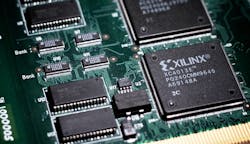Xilinx's Sales Climb as Strategy Shifts to Data Centers
Xilinx has expanded its efforts around artificial intelligence, networking and storage chores in data centers over the last year under chief executive officer Victor Peng. The Silicon Valley supplier has positioned its FPGAs as alternatives to CPUs, GPUs, DSPs and ASICs. The company has also been trying to lower the bar for programming FPGAs. The plan has resulted in strong sales growth at Xilinx.
The company's data center revenue has surged 40% over the last year as Amazon, Microsoft and other cloud computing players adopt FPGAs. Xilinx said that sales of its advanced products, including its Alveo and UltraScale processors, jumped 55% since last year's fourth quarter. The company's core products targeting video, audio, aerospace and other applications dropped 5% in the fourth quarter of 2019.
Business has been booming. Last week, the company reported revenues of $828 million in the fourth quarter, up 30% over last year's fourth quarter. Net profits came to around $245 million, or $0.95 per share, according to Xilinx. Total revenue for the 2019 fiscal year came to $3.06 billion, up 24% from 2018. For the full year, profits rose to $890 million, or $3.47 per share, an increase of 68% over the last year.
As part of the plan, Xilinx is also trying to muscle into the market for artificial intelligence. Xilinx claims its programmable chips can run artificial intelligence algorithms—a process called inferencing—using less power and with lower latency than competing chips. The company has positioned its chips as an alternative to Nvidia’s Turing GPUs and Intel’s Xeon CPUs, which are the current gold standard in inferencing.
The cornerstone of the company's data center strategy is its adaptive compute acceleration platform (ACAP). The company's Versal ACAP can be programmed by customers to handle many different data center applications. Customers can also reprogram ACAPs faster than FPGAs, Xilinx said. One major advantage of ACAPs and FPGAs is they can be adjusted as artificial intelligence algorithms change.
Xilinx is also doubling down on networking and storage devices that can be dropped into data centers. Last week, the company said that it would buy Solarflare Communications, a startup selling high-speed, low-latency, low-power networking devices based on Xilinx's FPGAs. Xilinx said it would combine its chips with Solarflare's network interface controller or NIC technology to create converged SmartNIC devices.
There are other challenges facing Xilinx. Cloud computing companies late last year started slashing their server chip spending, sending shockwaves through the semiconductor industry. Amazon, Microsoft, Google and other players have cut back capital spending to get through their accumulated inventory. Intel and Nvidia have both struggled amid the end of the spending surge. But Xilinx's growth has stayed strong.
The company is forecasting sales of $835 million to $865 million in the current quarter, up from $684 million in last year's first quarter. Operating profit is projected to be $535 million in the first quarter of the 2020 fiscal year. "We are executing to our strategy and focusing on growth across our portfolio as we continue our transformation to a platform company," Victor Peng, the chief executive of Xilinx, said in a statement.
About the Author
James Morra
Senior Editor
James Morra is the senior editor for Electronic Design, covering the semiconductor industry and new technology trends, with a focus on power electronics and power management. He also reports on the business behind electrical engineering, including the electronics supply chain. He joined Electronic Design in 2015 and is based in Chicago, Illinois.

